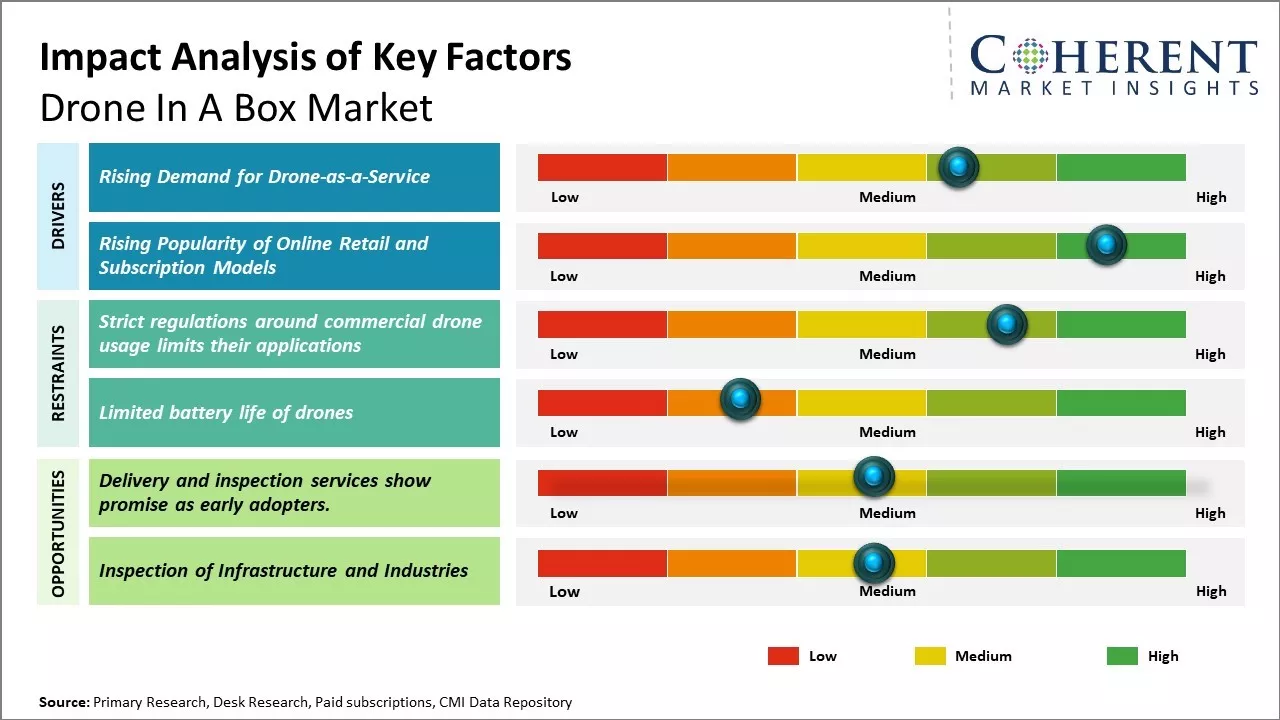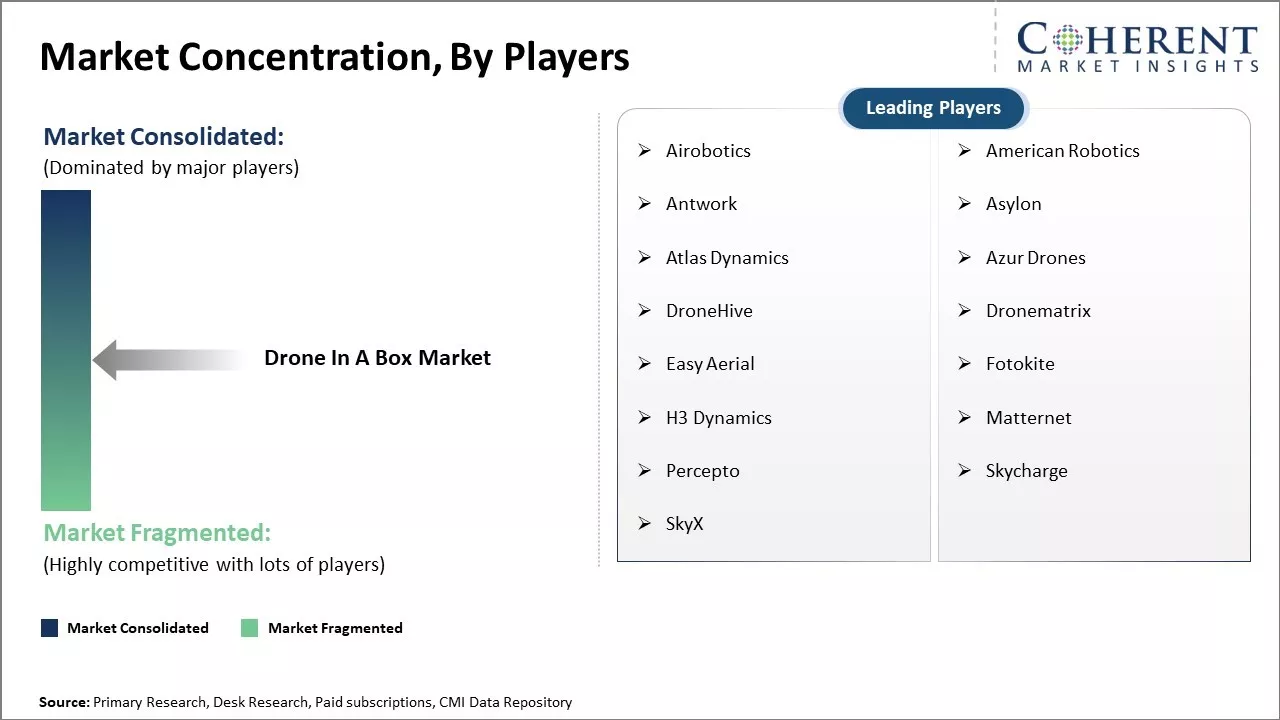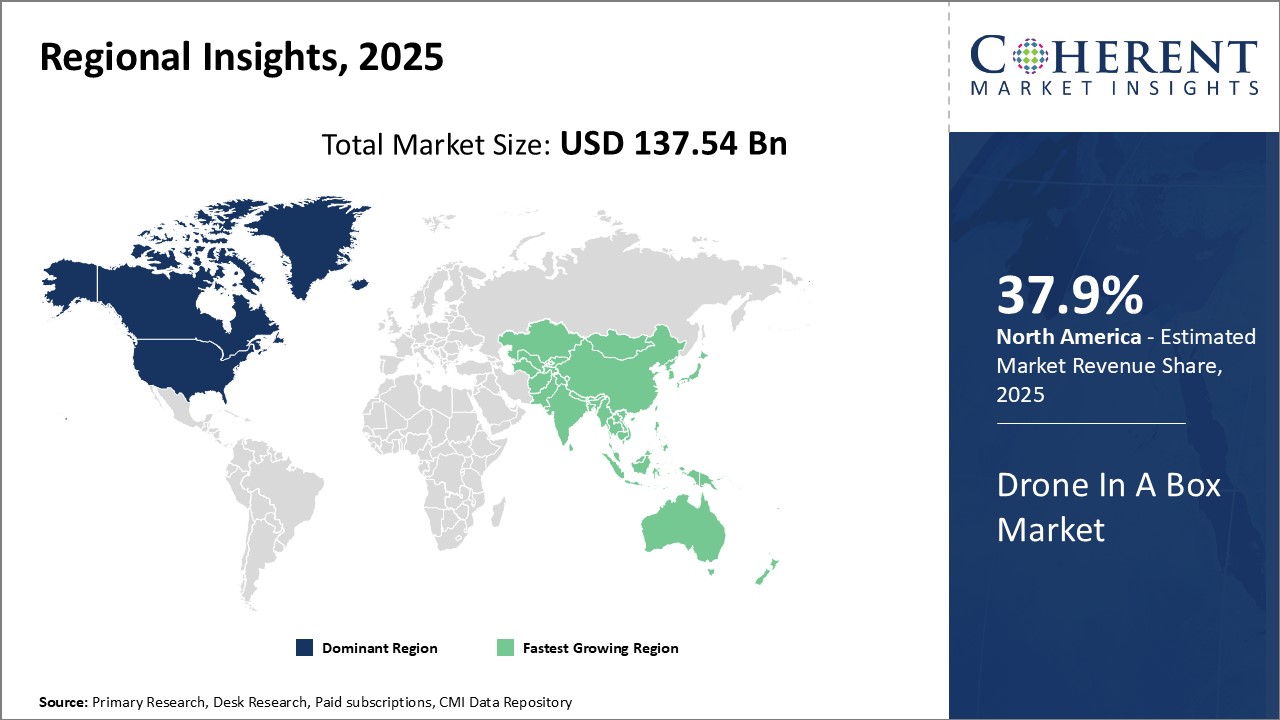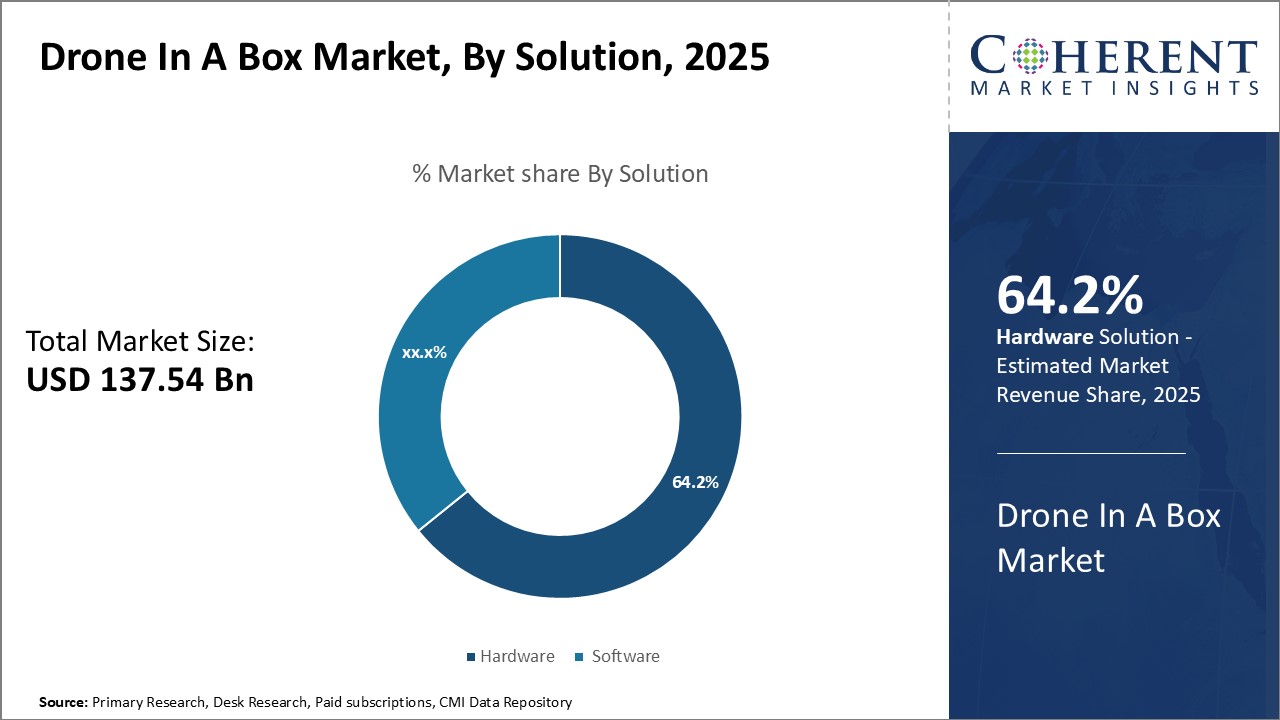Drone In a Box Market Size and Share Analysis – Growth Trends and Forecast (2025-2032)
The drone in a box market is estimated to be valued at USD 137.54 Bn in 2025 and is expected to reach USD 338.09 Bn by 2032, growing at a compound annual growth rate (CAGR) of 13.7% from 2025 to 2032.

To learn more about this report, Download Free Sample
Key Takeaways
- Based on the solution, the Hardware segment dominates the market with a 64.2% market share. This is due to the continuous innovation and flexibility provided by hardware.
- Based on type, the Multi-rotor drones segment has become the top-selling market leader, as they hold 69.7% of the market share. This is due to the responsive manoeuvrability and adaptability provided by several individual motors and propellers.
- Based on application, the Thermal imaging segment dominates the drone-in-a-box solution market with 28.9% market share. This is because thermal cameras measure infrared light emitted or reflected by objects to create a heat signature image.
- North America holds a dominant position in the drone in a box market owing 37.9% market share. This is due to its leadership position including the strong presence of major manufacturers and industry pioneers in countries like the U.S.
Market Overview
The market for the drone-in-a-box has been growing rapidly because the need for autonomous drone technology is increasing among industries. Businesses are now incorporating drone-in-a-box systems across a variety of applications, ranging from aerial inspections, monitoring, and delivery to surveillance. They provide an organized, one-package solution, de-cluttering the process of drone operations through the provision of drones, charging stations, software, and management platforms in one.
Nokia introduced a 5G-capable drone-in-a-box solution for infrastructure inspection in Europe in 2024. The technology holds out the promise of substantial cost savings and efficiency improvements, but tight rules governing BVLOS operations and airspace control remain a challenge. As regulations evolve, these systems will become increasingly deployed in industries other than aviation.
Current Events and its Impact
|
Current Events |
Description and its impact |
|
Expansion of Drone-in-a-Box Solutions for Logistics |
|
|
AI Integration for Enhanced Drone Autonomy |
|
Uncover macros and micros vetted on 75+ parameters: Get instant access to report
Role of technologies like AI in Drone-in-a-box Market
AI is key to the drone-in-a-box industry, which makes it possible to design completely autonomous drones that do not need human intervention. With AI algorithms, the drones are able to scan large volumes of data in real time, and therefore, are able to carry out highly complicated activities like navigation, evading obstacles, and data capture with high accuracy. Artificially intelligent drones possess machine learning features through which they can improve their performance continuously based on experience, lessening the requirements of manual coding and enhancing the efficiency of operations.
AI also improves the autonomous charging function in drone-in-a-box technology. Once the drones are back in their boxes to be charged, AI facilitates that they can land, dock, and come back to work autonomously with little downtime. AI combined with computer vision and sensor technologies enables the drones to fly in adverse conditions, like inclement weather or at night, by enhancing their perception and understanding of the environment.
Additionally, AI helps with predictive maintenance as it processes drone performance data to determine possible faults before they happen. This decreases the likelihood of operational malfunctions, keeping drones in prime condition for prolonged durations. Generally, AI plays a key role in maximizing drone-in-a-box systems' functionality, efficiency, and reliability, making them an acceptable solution across industries.
Role of Blockchain in the Market
Blockchain technology can greatly contribute to the drone-in-a-box sector by strengthening security, transparency, and data integrity. Its major function is to provide secure, tamper-evident transactions for data obtained through drones. For sectors such as agriculture, logistics, and infrastructure inspection, drones obtain vast amounts of essential information. Blockchain can hold this information in a decentralized ledger, making it immutable and verifiable, essential for audits, regulatory compliance, and decision-making.
Blockchain is also used in smart contracts for autonomous functionality. Such contracts can be programmed to perform operations such as drone maintenance, charging intervals, or service contracts, with the assurance that actions will only be taken when predetermined conditions are reached. This degree of automation simplifies drone operations and minimizes human intervention.
Also, blockchain can facilitate secure communication for drones through the guarantee of encrypted and tamper-proof data exchange among drones, ground stations, and other systems connected. This is particularly crucial in industries such as defense and surveillance, where security is of utmost concern.
Pricing Analysis
The cost of drone-in-a-box solutions is determined by factors like the category of drone, its features, the complexity of the docking system, and the degree of automation offered. In general, the systems include autonomous drones, charging stations, and a management platform, which contribute to the cost together. The average cost of a simple drone-in-a-box system can range from $10,000 to $50,000 based on specifications. More sophisticated systems, particularly those with AI capability, advanced sensors, or niche applications (e.g., security or farming), can reach prices higher than $100,000.
Market Drivers:
- Increasing Demand for Drone-as-a-Service
The business drone market has grown rapidly over the past few years, fuelled by technology that has miniaturized, made intelligent, and affordable drones. Drones used to need technical skills, specialist hardware, and software, which restricted their adoption to hobbyists and early adopters. New 'drone-in-a-box' solutions are now making it simpler than ever for organizations of all sizes to utilize drones.
In 2024, Skyports grew its drone-in-a-box solutions for city delivery, offering a turnkey package with drones, charging stations, and management software. This turnkey solution enables companies to implement autonomous drone delivery systems easily without specialized expertise.
Diverse sectors, such as real estate, agriculture, construction, and event planning, are finding more uses for drones in applications such as property advertising, crop surveillance, site design, and real-time event broadcasting. But many do not have the in-house expertise and capabilities to run an effective drone program. Drone-as-a-service solutions offer a turnkey solution for these new clients, handling regulatory compliance, pilot training, flight planning, and post-flight data processing so that customers can simply concentrate on incorporating drones into their workflow.
- Rising Popularity of Online Retail and Subscription Models
At the same time, changes in customer purchasing behaviour across many industries are benefiting drone-in-a-box companies. Younger generations, in particular, are more comfortable making large purchases like drones online without first handling the product in-store. They are also open to subscription-based models where specialized equipment like drones can be leased every month rather than requiring an upfront capital expenditure.
Drone-in-a-box vendors are responding by building strong direct-to-consumer websites that simplify the purchasing process through virtual product demonstrations, online configurators, and educational content. Their integrated subscription programs provide flexible access to complete drone systems on monthly plans that include insurance, repairs/replacements, training, and optional upgrades.
Market Concentration and Competitive Landscape

To learn more about this report, Download Free Sample
Market Opportunities:
- Delivery and inspection services hold potential as a pioneer
As regulations mature, increasing commercial and industrial uses will be uncovered. Delivery and inspection services are leading the way as early adopters. Miniaturization and decreasing prices will bring drones within the reach of much larger numbers of individual and SMB users. Continuing improvements in drone technologies around battery life, autonomy, and payload capacity.
In 2024, Wingcopter diversified its drone delivery capabilities, employing miniaturized autonomous drones for effective medical supply delivery in remote locations, highlighting developments in autonomy and payload. At the same time, DHL launched drone inspection services for infrastructure, further highlighting commercial applications of drones. These examples demonstrate how technology and changing regulations are driving wider industry adoption.
Insights, By Solution- Hardware provides the greatest proportion of the market due to hardware innovation and flexibility.
The hardware segment is in dominating the global drone-in-a-box industry in 2025, owing to continuous innovation, and flexibility provided by the hardware. Hardware is the central part of any drone solution, hence the importance of innovation in this part for its uptake. With more durable and light materials, it has become possible to achieve more payload capacities as well as flying times.
Insights, By Type- Multi rotor accounts for the largest proportion of the market due to versatility and agility.
In the type category, multi-rotor drones have become the top-selling market leaders in 2025. The major reason is their responsive manoeuvrability and adaptability provided by several individual motors and propellers. This makes multi-rotors extremely good at hovering, and also, they can easily move through restricted and dense spaces. Vertical take-off and landing capability further simplifies deployment.
Insights, By Applications: Seeing is Believing: On an application basis, thermal imaging offers the greatest percentage of the market due to additional functionality
Thermal imaging has become the top category of application for drone in a box solution in 2025. Thermal cameras measure infrared light emitted or reflected by objects to create a heat signature image. This enables applications outside of visual line of sight with the use of only thermal contrasts.
For example, thermal imaging assists structural engineers in finding out such problems as cracks, seepage of moisture, or infestation by pests behind surfaces that are not visible to the naked eye. It has assisted rescue teams in finding persons in smoke/fog by thermal signatures. Firefighters can chart fire boundaries and cooling areas with accuracy with thermal. Farmers employ it to evaluate the condition of crops/soil during day or night hours.
Regional Insights

To learn more about this report, Download Free Sample
North America Drone In a Box Market Analysis and Trends
North America has emerged as the dominant region in the drone-in-a-box market, accounting for 37.9% in 2025. Several factors have contributed to its leadership position, including the strong presence of major manufacturers and industry pioneers in countries like the U.S. Companies, such as DJI, 3DR, and Yuneec, have cemented their position in this region with their innovative product offerings catering well to the requirements of professional as well as hobbyist users.
In addition, the region is home to a vibrant community of drone operators, photographers, and videographers who are at the forefront of exploiting the technology for various commercial applications. This has ensured steady demand and provided a fillip to local manufacturers to further strengthen their foothold.
Drone-in-a-box market Dominating Countries
United States Drone-in-a-box Market Analysis and Trend
The United States leads the market for drones-in-a-box, spurred by its huge investments in commercial and military drone technology. Companies like American Robotics and AeroVironment, both from the United States, are leading the way with autonomous drone solutions for numerous applications, ranging from agriculture to infrastructure inspection and surveillance.
China Drone-in-a-box Market Analysis and Trend
China is second only to the United States, with DJI companies dominating the international drone market, albeit so far concentrated on consumer drones. China's expanding passion for autonomous systems has also resulted in heightened investments in drone-in-a-box solutions aimed at both industrial and commercial markets.
Market Report Scope
Drone In A Box Market Report Coverage
| Report Coverage | Details | ||
|---|---|---|---|
| Base Year: | 2024 | Market Size in 2025: | USD 137.54 Bn |
| Historical Data for: | 2020 To 2024 | Forecast Period: | 2025 To 2032 |
| Forecast Period 2025 to 2032 CAGR: | 13.7% | 2032 Value Projection: | USD 338.09 Bn |
| Geographies covered: |
|
||
| Segments covered: |
|
||
| Companies covered: |
Airobotics, American Robotics, Antwork, Asylon, Atlas Dynamics, Azur Drones, DroneHive, Dronematrix, Easy Aerial, Fotokite, H3 Dynamics, Matternet, Percepto, Skycharge, and SkyX |
||
| Growth Drivers: |
|
||
| Restraints & Challenges: |
|
||
Uncover macros and micros vetted on 75+ parameters: Get instant access to report
Drone In a Box Industry News
- In February 2025, DJI launched the Dock 3, a tough drone-in-a-box solution that is compatible with the Matrice 4D and 4TD drones. It is designed to be transported in pickup trucks and allows autonomous take-off from moving vehicles, perfect for infrastructure inspections and remote monitoring. The system can function in harsh temperatures and accommodate BVLOS missions with cellular connectivity.
- In May 2025, DoorDash collaborated with Wing to introduce drone delivery services in Charlotte, North Carolina. Residents in a four-mile radius of The Arboretum Shopping Center are now able to receive instant drone deliveries, an important milestone for urban drone logistics.
Analyst View
- The Drone-in-a-Box (DIAB) industry is set to experience revolutionary growth based on growing industrial automation and demand for scalable, autonomous solutions by industries. Among the drivers of this growth is the transition toward drone-as-a-service models that allow industries such as energy, agriculture, and infrastructure to adopt DIAB systems for inspections, surveillance, and data gathering purposes without incurring massive initial investment in expertise or infrastructure.
- The defense industry further drives adoption, utilizing DIAB for ongoing monitoring and tactical operations, underpinned by increasing investments in unmanned systems. Still, regulatory issues surrounding beyond-visual-line-of-sight operations and data privacy issues remain major hindrances, especially in countries with robust airspace policies. Opportunities are in new applications like solar farm maintenance and telecommunications, where autonomous drones minimize downtime and improve safety when performing inspections.
- Combination with IoT and AI to drive real-time analysis and predictive maintenance can release further value to allow proactive decision-making. Regionally, the Asia-Pacific market is becoming a high-growth region as it witnesses fast industrialization and smart city projects, whereas Europe's emphasis on green infrastructure and regulatory consistency allows gradual uptake.
Market Segmentation
- Solution Insights (Revenue, US$ BN, 2020 - 2032)
- Hardware
- Software
- Type Insights (Revenue, US$ BN, 2020 - 2032)
- Single Rotor
- Multi Rotor
- Applications Insights (Revenue, US$ BN, 2020 - 2032)
- Surveying & Mapping
- Inspection
- LiDAR
- Monitoring
- Thermal Imaging
- Security & Emergency Response
- Others
- End-use Industry Insights (Revenue, US$ BN, 2020 - 2032)
- Defense
- Construction & Mining
- Oil & Gas
- Homeland Security
- Medical Services
- Transportation & Logistics
- Event Management
- Others
- Regional Insights (Revenue, US$ BN, 2020 - 2032)
- North America
- U.S.
- Canada
- Latin America
- Brazil
- Argentina
- Mexico
- Rest of Latin America
- Europe
- Germany
- U.K.
- France
- Italy
- Russia
- Rest of Europe
- Asia Pacific
- China
- India
- Japan
- Australia
- South Korea
- ASEAN
- Rest of Asia Pacific
- Middle East & Africa
- GCC Countries
- South Africa
- Rest of Middle East & Africa
- Key Players
- Airobotics
- American Robotics
- Antwork
- Asylon
- Atlas Dynamics
- Azur Drones
- DroneHive
- Dronematrix
- Easy Aerial
- Fotokite
- H3 Dynamics
- Matternet
- Percepto
- Skycharge
- SkyX
Sources
Primary Research Interviews:
- Drone-in-a-Box manufacturers
- Autonomous navigation system suppliers
- Enterprise end-users (energy/utilities sector)
- Regulatory compliance experts
- Others
Databases:
- Statista Drone Technology Database
- Bloomberg Energy & Utilities Intelligence
- IBISWorld Drone Services Reports
- PitchBook Venture Capital Analysis
- Others
Magazines:
- Commercial Drone Professional
- Robotics Business Review
- Unmanned Systems Technology
- Energy Industry Today
- Others
Journals:
- Journal of Intelligent & Robotic Systems
- IEEE Transactions on Automation Science
- International Journal of Advanced Robotic Systems
- Remote Sensing Applications Journal
- Others
Newspapers:
- The Wall Street Journal (Tech Section)
- Financial Times (Innovation Reports)
- DroneLife Industry Briefs
- TechCrunch Startup Coverage
- Others
Associations:
- Association for Uncrewed Vehicle Systems International (AUVSI)
- Small UAV Coalition
- Global Drone Federation
- International Federation of Robotics
- Others
Public Domain Sources:
- FAA Drone Regulation Updates
- EASA Policy Documents
- U.S. Department of Energy Reports
- European Commission AI in Robotics Whitepapers
- Others
Proprietary Elements:
- CMI Data Analytics Tool
- Proprietary CMI Existing Repository of information for last 8 years
*Definition: Drone in a box is an affordable and user-friendly drone product designed for beginners and casual users. It comes fully assembled in a compact box, ready to fly right out of the package. With an easy one-button takeoff and landing feature, it is incredibly simple to operate. Users can control the drone's flight and take aerial photos or videos using a mobile app.
Share
Share
About Author
Suraj Bhanudas Jagtap is a seasoned Senior Management Consultant with over 7 years of experience. He has served Fortune 500 companies and startups, helping clients with cross broader expansion and market entry access strategies. He has played significant role in offering strategic viewpoints and actionable insights for various client’s projects including demand analysis, and competitive analysis, identifying right channel partner among others.
Missing comfort of reading report in your local language? Find your preferred language :
Transform your Strategy with Exclusive Trending Reports :
Frequently Asked Questions
EXISTING CLIENTELE
Joining thousands of companies around the world committed to making the Excellent Business Solutions.
View All Our Clients

